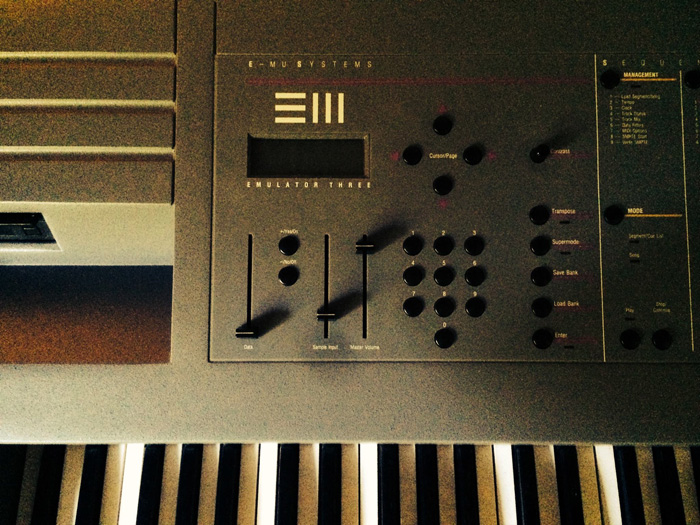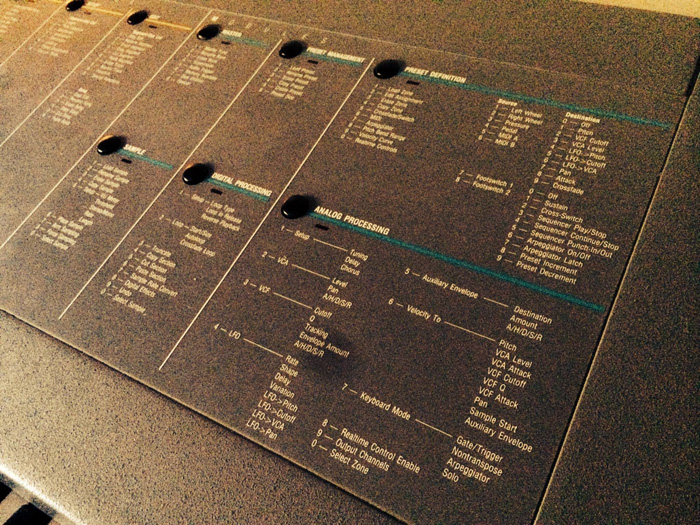Emu E3

EMU EIII
Emu E3 - Introduction
If there is a sampler that can be bestowed the title of "crown jewel" in Emu's Emulator series, it is without a doubt the Emulator 3. Released in 1988, it came into an already competitive marketplace. On the affordable end of the sampler market, there was the Akai S range with the S950 and S1000 samplers. On the expensive side, the Fairlight Series 3 sampler and the Synclavier system, which at this time had full multitrack hard disk recording as well as sample playback, were the main stays of large ssl equipped studios and production houses. However, due to its feature set, tonal integrity, and user friendliness, the E3 was able to carve a place for itself.
Emu E3 - Basic Specs
The E3 came in two models, a rack mount and a full 61 key keyboard. The rack mount was not made in great quantities and remains a rare sight to this day so this review focuses on the more accessible keyboard version. The keyboard version came in two models, a 4mb and an 8mb model. Both revisions were expensive, even at the time, with the 8 meg version costing over 15,000 us dollars. And what did that money get you? A highly sophisticated, state of the art sampler that sampled and played back at glorious 44.1 / 16 bit cd quality resolution. Unlike the previous emulators, the 2 and the 1, the E3 was the first Emulator to embrace a new custom chip from EMU for it's digital magic, and what a difference! But more on the sound later. Let's look at the specs.
The E3 is a 16 voice sampler that features an analog filter and VCA per voice. The filter is based around a curtis chip, the CEM3387, which is a fully resonant analog filter. This same chip was also used in the Waldorf Wave / Microwave range of wavetable synthesizers. The E3 has discrete Attack, Hold, Decay, Sustain, Release envelopes for the Amp as well as for the filter. There is also an additional auxiliary envelope that can be used for pitch bending in addition to other functions. These envelopes are fully editable and feel like working with a synth rather than a sampler. There is also an LFO on board, that can be routed to almost any core synthesis function and offered several waveforms. It has a fully variable speed but doesn't quiet make it into the audio range, as with modern LFOs.
Each voice has a discrete output on the back panel of the E3 -- thats a total of 16 individual voice outputs-- which conveniently denormals from the main out when used. Assign a kick sample to voice 1, plug a cable into voice 1, and voice 1 disappears from the Main stereo output, just like on a TR808. As mentioned, there is a stereo output, as well as a stereo input of which both ins can be used to record true stereo samples, at the expensive of double ram usage.
The E3 has a sophisticated 16 track sequencer that can also sequence external midi gear and can call back 100 sequences and 100 songs within one bank. The sequencer also features a sophisticated song mode, auto quantize settings, as well as a plethora of clocking options, including smpte! Similarly to the customizable nature of the sequencer clocking, the stereo sampling inputs can be turned into trigger inputs so that drum pads, or an analog trigger from a sequencer or a drum machine can fire off a sample. This was particularly useful for drum replacement work in the studio.
Emu E3 - Feature Details / Architecture

EMU EIII
The E3, with it's new Emu designed F chip, featured a sophisticated digital processing section to allowed the user to not only operate basic sampler functions like trimming and reversing samples, but also dive into more complex matters like crossfade looping. Because a large part of the crossfade looping function was automated and interpolated by the E3s processor, the user could focus on practical parameter setting in plain english (milliseconds and amount) rather than some convoluted sampler-speak. Ensoniq Mirage I'm looking at you! Due to the ground breaking precision nature of this new F-Chip, this meant that making seamless loops on the E3 was a breeze. It is for this very reason why the E3 could convincingly emulate analog synthesizers -- in other words the clicks and pops associated with looping on hardware samplers was relinquished to non existence due to the superb processor on the emulator 3.
In addition to these more fundamental functions, there was also an offline DSP processing section. This included everything from changing the pitch of a sample, to time stretching, to reversing samples. While some of these processor heavy functions could take a while to render changes to a long sample, if you didn't like the result the E3 had a very handy undo function. It was a single history step backwards but it had the potential to save your ass if your beautiful pizzicato sample was time stretched into a 90's drum n bass break transition.
Lastly, the E3 has a beautiful 61 full keyboard and a highly intuitive user interface. The keyboard is a dream to play and has the key action of a world class keyboard. It truly feels like you've made it holding a massive major seventh chord of a giant choir sample with this exceptional keyboard. Conveniently, all of the editing and programming functions are clearly printed on the front panel of the E3, which makes programming, in conjunction with the large, backlit display, a breeze. Once you've been initiated into the way the e3 OS works, everything feels like it is within reach. Also, there is a very high quality data slider, which can be used to seamlessly change parameter values, but if precision is needed, there are incline and decline buttons as well. And all of the buttons on the E3 feel of quality and give off a very satisfying click with every press.
Emu E3 - Sound
If two words are needed to characterize the sound of the E3, they would be sophisticated and emotional. I have not heard any other sampler that his this intensity, warmth, width but also cleanness that the emulator 3 does. Yet, it is still moody and somewhat dark. It truly is one of the few samplers that can transform any input material into something almost unrecognizable, but better than what you put in. Strings, pads, and chordal sounds are the highlight here. Due to the the 16 voices, a user can create full beds of melodic sound that easily fill in the empty space. And unlike a lot of digital workstation romplers, the sound is full of charisma and 3d depth.
Also, the low end on the E3 is breathtaking. The bottom octave, no matter how much transposing is happening past the root key of a sample, pushes with warmth and edge unlike any other sampler I've heard. One of my favorite sounds to sample into the E3 is a wavetable from the PPG wave. I tend to keep the wavetable somewhat static but with reverse backwards / forwards looping I can not only create the illusion of wavetable synthesis, but also polish it off with the world class curtis analog filters that pin the sound even closer to a real PPG Wave. And when coupled with the E3s special chorus, which effectively halves the voice count to 8 but stacks a second layer of your main sample slightly detuned, you're in for a transformative experience.
Because the process of programming the E3 is so synth-like, you'll find yourself making lots of patches very quickly and you'll be happy to know that once you have some basic patches saved, navigating all your sounds is basically the same as on any serious polyphonic analog synth. The display shows you the patch and you can seamlessly select new patches in the loaded bank without any loading time. In fact, if you have a sound with long envelope release times still ringing out while you switch patches, the E3 won't cut the sound but will instead load the new patch and allow you to play it until the round robin voice allocation scheme eats up the ringing voices. And with 16 voices, this will take a while.
Review by Matia of INHALT
E3 - Demo Video
Demo by INHALT



